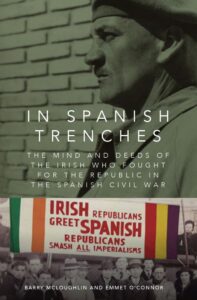Book Review: The Minds and Deeds of the Irish who Fought for the Spanish Republic
 Spanish Trenches: The Minds and Deeds of the Irish who Fought for the Spanish Republic in the Spanish Civil War, by Barry McLoughlin and Emmet O’Connor. University College of Dublin Press, 2020. 400 pp. $35.
Spanish Trenches: The Minds and Deeds of the Irish who Fought for the Spanish Republic in the Spanish Civil War, by Barry McLoughlin and Emmet O’Connor. University College of Dublin Press, 2020. 400 pp. $35.
Touted as the “definitive study of the Connolly Column,” McLoughlin and O’Connor’s In Spanish Trenches delivers a robust account of Irish involvement in the Spanish Civil War. The book is a rich source of information on the Irish volunteers providing valued context that enables the reader to better understand the motivation of those volunteers. In Spanish Trenches interweaves three storylines: Irish Politics in the 1930s; the contribution of Irish volunteers in the International Brigades; and the important role played by Frank Ryan in both Ireland and Spain in supporting the Republican cause.
The book changed how I approached the topic. Instead of “why were there so few Irish volunteers?” I asked myself “how did Ireland manage to send as many volunteers as it did?” McLoughlin and O’Connor identify 247 Irish-born International Brigade volunteers of whom 25% came directly from Ireland. This was a significant accomplishment considering the overwhelming pro-Franco stance of the Catholic church within Ireland. The small Irish Communist Party (CPI) was ill-equipped to provide either significant numbers of volunteers or other support to the Spanish Republic. Despite the obstacles, the CPI banded with other left-leaning parties and associations including the Left Book Club, Spanish Aid Committee, and Progressive Publications Society, to form a loose coalition supporting Republican Spain. These groups raised funds for relief supplies and attempted to sway public opinion toward the embattled Loyalists.
In Spanish Trenches examines the Irish volunteers both collectively in the text and as individuals in the appendix. The appendix provides the name of the volunteer, place of birth, domicile, political affiliation, arrival in Spain and fate. McLoughlin and O’Connor also examine the day-to-day experiences and battles in which the Irish participated. Their examination spans the entire period of Irish activity, from the formation of the British No. 1 Company in 1936 to the withdrawal of the Internationals in September 1938.
McLoughlin and O’Connor also give attention to some of the controversial incidents in involving Irish volunteers in Spain. For example, the decision by some Irish volunteers to transfer from the British battalion to the American Lincoln battalion just before Jarama and the execution of Irish machine-gunner Maurice Ryan, who was accused of firing on his own men during the Ebro Offensive. In these incidents the authors present the events from multiple perspectives identifying underlying causes and context that led to the decisions made.
McLoughlin and O’Connor consulted Irish, British, German, Russian, and Spanish archives while researching the book. They provide an extensive bibliography and concise footnotes. Yet, some small errors did slip through. For example, in one part of the book, Oliver Law is identified as the commander of the George Washington battalion. Law commanded the Abraham Lincoln battalion, a fact cited correctly later in the text. This small misstep does not detract from the overall scholarship of the work. The book also includes well-chosen photographs and maps that support the text.
McLoughlin and O’Connor’s research uncovered new archival evidence regarding Frank Ryan’s trial. Ryan, the “acknowledged” leader of the Irish in Spain, was captured, tried and convicted by a Nationalist court martial and sentenced to death for “adherence to the rebellion.” A non-communist and practicing Catholic, Ryan accompanied one of the first contingents of Irish to arrive in Spain. He distinguished himself during the Battle of Jarama by rallying the shattered remnants of the British battalion and leading them back to their original battle position. Shortly thereafter Ryan left Spain on a speaking tour for Republican Spain in Ireland. When he returned, he was appointed editor of The Book of the XVth Brigade. During the Retreats Ryan was captured in the ambush of the British battalion at Calaceite. McLoughlin and O’Connor’s research uncovered documents dealing with Ryan’s incarceration and trial that provide a better understanding of the decision to hold Ryan long after the release of most international prisoners.
In Spanish Trenches presents sufficient new material to inform both longstanding students of the Spanish Civil War as well as those who are reading about the war for the first time.












